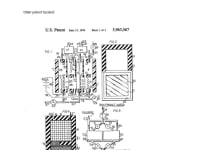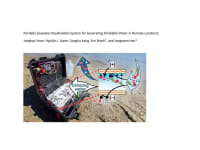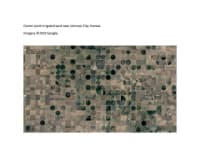Most desalination water separation is focused on drinking water, making water so pure, that the process of salt removal is almost a byproduct.
This idea focuses solely on removing enough salt to make water safe for irrigation only. By focusing on this goal, the idea will generate irrigable water 10x to 100x less costly than drinking water. It is expected that the cost of irrigation with seawater will be less than current freshwater irrigation wells, assuming proximity to a saltwater source.
A surprising amount of land close to oceans and seas is arid, but arable. To make them productive, simply add water. Irrigation farming is effective and productive. In the US, many areas of the Midwest have been transformed through center pivot irrigation. Increased vegetation in arid seaside areas will reduce temperature extremes and act as an effective carbon sink. In addition to providing food from crops, with enough land conversion, climate change can be impacted.
What is the technology that can accomplish this transformation? Is it feasible? Saltwater is merely salt in a water solution. That is, Na+ and Cl- ions are floating in water. As charged particles, an applied field can move them. Since they can be moved, they can be concentrated.
This property of ion movement and concentration was the basis for US patent number 3,963,567, issued June 15, 1976. Although never commercialized, and now expired, this patent reinforces the idea that applied fields can be used to change the concentrations of ions in a solution. A similar patent, US 8,197,684, issued Jun 12, 2012, and numerous others highlight the unrealized promise of this technology.
Recently, Jongyoon Han and Eric Brack (April 28, 2022, (https://news.mit.edu/2022/portable-desalination-drinking-water-0428) successfully demonstrated an economical, low power device to generate drinking water from seawater. The first stage of the device is the use of an electric field to concentrate and remove the salt ions from the water solution. As the device generates approximately 0.3 Liter per hour, it certainly could not irrigate a field. It can, however, be used to study and scale using a field to concentrate and remove the Na+ and Cl- ions from seawater. By not converting to drinking water, most of the filtration needs, reverse osmosis, and system pressures are eliminated. The costs and maintenance requirements are also significantly reduced. How much does this solution need to be scaled to meet irrigation needs? Center pivots use about 700 gpm. Comparing this to 0.3 Liter per hour gives a scale factor of approximately 500,000x!
Needs of this project:
- continue the work of Han and Brack in ion concentration polarization (ICP).
- study and scale the field technology used in their device.
- build and demonstrate the first prototype.
The prize and publicity of this contest would go a long ways to developing this much needed technology. Thank-you for your consideration.
Like this entry?
-
About the Entrant
- Name:Craig Callewaert
- Type of entry:individual
- Software used for this entry:no
- Patent status:none








